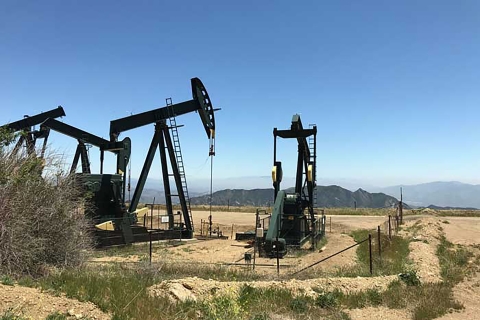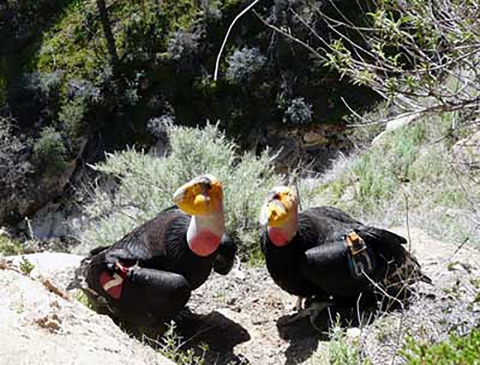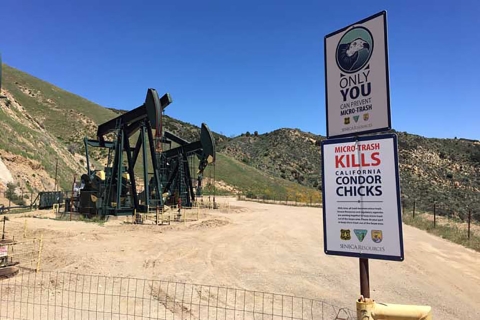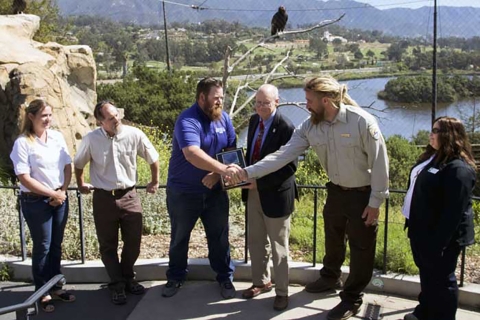By The Santa Barbara Zoo and the U.S. Fish and Wildlife Service
Can a committed conservationist find happiness with a guy whose living focuses on the search for oil?
Absolutely, provided the two share a core belief: that conservation and industry can go hand-in-hand — yes, just as they do. The Faiths — Nadya and Luke — can show you how it’s done.
Nadya Seal Faith is a conservation biologist with the Santa Barbara Zoo; Luke Faith is a foreman for Seneca Resources Inc., an oil-production company.
The zoo, her employer, has worked for more than a decade with the U.S. Fish and Wildlife Service’s (Service) California Condor Recovery Program.
His employer, the oil company, has operations adjacent to Hopper Mountain National Wildlife Refuge where — yes — biologists work to preserve the condor. The massive bird, with a 9.5-foot wingspan, once hovered on the brink of extinction and was among the first species protected under the Endangered Species Act.
This is no case of “Romeo and Juliet,” Seal Faith said.
“I’m no contemporary Capulet, and my husband is no modern-day Montague, but that does not stop the questions we get when people first learn what we do for a living,” she said. “Without fail, I’ll get a finger pointed at me while I hear, ‘So wait, you’re a conservation biologist,’ and then the ‘look’ toward my husband.”
The look, she said, invariably leads to the question: “‘So how do you make that work?’”
Her response? “It’s because we love each other.”
There’s another reason, too. Conserving wildlife and producing oil aren’t mutually exclusive.
A storied history
Oil exploration and production have a rich history in Ventura County, California, where the Faiths live and work. Union Oil, the oldest oil company in the west and now a subsidiary of Chevron, was founded in Ventura County in 1890. Today, the industry employs just under 9,000 people in Ventura County, and generates more than $172 million in state and federal tax revenue.
Some of the wells in the Sespe oil field are adjacent to Hopper Mountain NWR. The refuge, established in 1974, supports a variety of habitats, including more than 900 acres of grassland foraging area for condors. The refuge also buffers the Sespe Condor Sanctuary in Los Padres National Forest from the sprawling Los Angeles metropolis about 50 miles southeast. There are 17 wells on the refuge.
Seneca took over roughly half of the Sespe oil field in the 1980s; today, it operates the majority of the leases located there. An oil lease is an agreement between a land owner and an oil and gas company that allows the company access to the property and the minerals within.
As Seneca’s operations grew, so did the effort to save the endangered California condor. The California Condor Recovery Program is credited with keeping these birds aloft, figuratively and literally.
As the last of the wild California condor population steadily dwindled primarily due to a variety of human-related factors, including lead poisoning, biologists made a bold decision to capture the birds before it was too late; they brought the last wild bird into a captive flock in 1987. They hoped to breed enough birds to reintroduce them into their historic range.
Five years later, in 1992, scientists released a handful of captive-bred birds into the Sespe Condor Sanctuary — knowing, even as the birds took wing, that the condors were close to the Seneca oil fields. But that site was a place where condors historically foraged and nested.
The scientists crossed their fingers.
Collaboration for conservation
Both Seneca Resources and the Service wanted to prevent California condors putting themselves at risk by going near oil field equipment.
The Service looked at Seneca’s operations and recommended building fences around the leased areas. This was an inexpensive and effective way to keep the big birds out of harm’s way — proof, too, that the Service wanted to work with the oil company. Those fences are still in place today.
The innovations didn’t stop there. Following the birds’ release into the wild, several died after striking power lines. The fatalities weren’t Seneca’s fault; they didn’t occur on Seneca’s oil fields. Even so, the company identified potential hazardous lines on its site and buried them.
The company turned its attention to other possible dangers. Due to the curious nature of condors, they have drowned in water tanks or died after getting entangled in machinery. On the well locations any gas or liquid that is stored on site is covered, including water tanks; any length of wire, rope, or cord is secured when not in use by machinery. The company also installed bird deterrents on pumping units to prevent condors from landing on temporary stationary oil pumps, putting them at risk for injury.
There was a microtrash risk, too. Microtrash — tiny bits of debris — are attractive to scavenging condors. Parent birds often pick up the microtrash and feed it to their young, with fatal results.
Seneca and the Service created a microtrash clean-up plan that includes educational signs, training for oil workers, and monthly trash pickups on oil leases and roads. These efforts have helped Seneca create a conservation-minded workforce.
“We play a unique and vital role in the protection of the California condors and it is not a responsibility that we take lightly,” said Sean Brake, Seneca’s West division director. “The public and our agency partners hold us to a high standard and we strive to exceed that standard every day. We are all stakeholders when it comes to protecting the environment and endangered species.”
In 2017, The Santa Barbara Zoo and the Service recognized the company for its “exceptional cooperative efforts with the California Condor Recovery Program.” Because of the cooperation between public agency and private company, condors and oil production in the Sespe are thriving.
Returns on investment
Those long-ago crossed fingers must have worked. Today, an estimated 80 wild California condors use the Sespe region for roosting, foraging and nesting. The total wild population is nearing 280 birds, with another approximately 170 birds in captivity.
The Service, said Luke Faith, demonstrated that it was pro-condor — not anti-oil.
“The Service came in with an open mind: willing to communicate and educate about the type of management condors needed to recover, and willing to learn what it takes to operate an oil field,” he said. “They did not impose restrictions, but instead made recommendations based upon our shared knowledge of one another’s resources and limitations.”
Dave Ledig, the Service’s project leader at Hopper Mountain NWR, returned the compliment.
“The relationship we’ve built with Seneca over the years is invaluable,” he said. “Not only for their proactive contributions to California condor recovery, but also for their willingness to come to the table, have a conversation and share information.”
The collaboration surely extends to the Faith family.
“My husband and I make our relationship work because we follow basic tenets that allow for success in any relationship,” said Seal Faith.
“…Just because I work toward and care deeply about conservation doesn’t mean I can’t appreciate how petroleum-based products enrich my life,” she said. “And just because my husband works for a petroleum company doesn’t mean that he can’t spend his leisure time enjoying nature through hiking, fishing and even birding.
“We’ve found happiness not in spite of what we do, but because we’re able to learn from each other and strengthen our relationship because of it.”
*Editor’s note: As of May 2018, Seneca Resources’ Sespe oil fields are managed by Carbon Natural Gas Company.
Nadya Seal Faith is a conservation and science associate with the Santa Barbara Zoo.
The U.S. Fish and Wildlife Service supported this Nature's Good Neighbor through a decades-long collaborative relationship between the California Condor Recovery Program and Seneca Resources, Inc.









